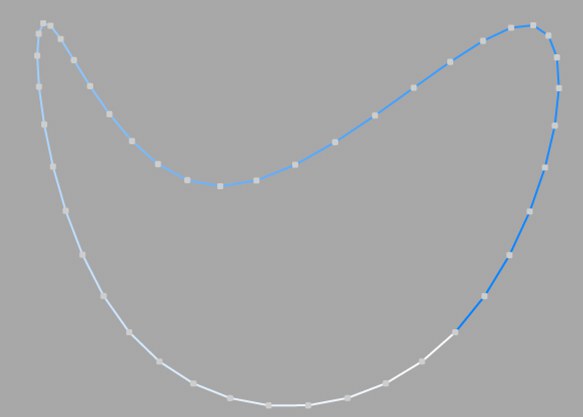 Arc Object 圆弧对象Basic 基础Coord.Object 对象
Arc Object 圆弧对象Basic 基础Coord.Object 对象
Object Properties
对象属性
类型
With this option you choose the circle element to be used in your arc. Choose from Arc, Sector, Segment and Ring.
使用此选项,您可以选择要在弧线中使用的圆形元素。从弧,扇区,段和环选择。
分段环
 From outer to inner: Arc, Sector, Segment and
Ring 从外到内: 弧,扇区,段和环
From outer to inner: Arc, Sector, Segment and
Ring 从外到内: 弧,扇区,段和环
半径[0. . + ∞ m ]
Defines the circle radius from which the circular element is to be created.
定义要从中创建圆形元素的圆半径。
内半径[0. . + ∞ m ]
If you set Type to Ring, this defines the inner radius of the ring.
如果将 Type 设置为 Ring,这将定义环的内部半径。
Start Angle[-360..360°]
End Angle[-360..360°]
起始角度[-360. . 360 ° ]终止角度[-360. . 360 ° ]
Using these two values you can define the start and end point of the arc element. 0° defines the value as the positive X axis, 90° the positive Y axis, 180° the negative X axis, etc. These examples assume you are working in the XY plane, as mentioned earlier.
使用这两个值可以定义 arc 元素的起点和终点。0 ° 定义值为正 x 轴,90 ° 为正 y 轴,180 ° 为负 x 轴,等等。这些例子假设您正在 XY 平面上工作,如前所述。
飞机
With this drop-down list you choose in which of the three planes the spline primitive is created.
使用这个下拉列表,您可以选择在三个平面中的哪个平面创建样条基元。
倒车
Enabling this option will reverse the point order of the spline (see also Spline Primitives.
启用此选项将颠倒样条的点顺序(也请参阅样条基元)。
中间点
Here you can define how the spline is further subdivided with intermediate points. This affects the number of subdivisions created when using the spline with Generator objects. Even after you select the Interpolation type from the menu for the Intermediate Points, you can still make changes.
在这里,您可以定义如何用中间点进一步细分样条。这将影响使用样条函数对 Generator 对象时创建的细分数。即使在您从菜单中选择了 Intermediate Points 的插值类型之后,您仍然可以进行更改。
没有

This method of interpolation locates points only at the vertices of a spline, using no additional intermediate points. You cannot enter values into the Number or Angle boxes. For B-splines, the vertices, and therefore points, might not be located on the spline curve.
这种插值方法只在样条曲线的顶点处定位点,不使用额外的中间点。不能在“数字”或“角度”框中输入值。对于 b 样条曲线,顶点和点可能不位于样条曲线上。
自然

This interpolation type first locates points at spline vertices. In the case of B-splines, points are located at positions on the spline curve closest to the spline vertices. Number (N) corresponds to the number of intermediate points between vertices. The points are positioned closer together on areas of the spline with more curvature.
这种插值类型首先定位样条顶点上的点。在 b 样条的情况下,点位于样条曲线上最靠近样条顶点的位置。Number (n)对应于顶点之间的中间点的数目。这些点被定位在更接近的曲率花键区域。
You cannot enter values into the Angle box. The interpolation is not affected by reversing the point order.
无法在“角度”框中输入值。反转点顺序不会影响插值。
制服

This interpolation subdivides the spline so that the distance between any two consecutive points, as measured along the spline curvature, is constant. One point is always located at the beginning vertex. For open splines, a point is also located at the ending vertex. Other points generally do not coincide with vertices.
这种插值对样条进行细分,使得沿样条曲率测量的任意两个连续点之间的距离是常数。一个点始终位于起始顶点。对于开放样条,一个点也位于结束顶点。其他点通常与顶点不重合。
You cannot enter values into the Angle box. The interpolation is not affected by reversing the point order.
无法在“角度”框中输入值。反转点顺序不会影响插值。
For 为了Natural 自然 and 及Uniform 制服 interpolation, the number of intermediate points is calculated as follows: 根据内插法,中间点的数目计算如下:Open spline: ((Number + 1) * (number of vertices - 1)) + 1
开放样条: ((数 + 1) * (顶点数-1)) + 1
Closed spline: (Number +1) * number of vertices
闭样条: (数 + 1) * 顶点数
So an open spline with four vertices and a number of 2 will contain ((2+1)*(4-1))+1=10 intermediate points. If the spline is then closed, a further (virtual) vertex is added — the number of intermediate points will then be (2+1)*4=12. This ensures that a spline is not more roughly divided when you close it.
所以一个有四个顶点和一些2的开放样条将包含((2 + 1) * (4-1)) + 1 = 10个中间点。如果样条函数是闭合的,那么再加上一个(虚)点ー中间点的数目将是(2 + 1) * 4 = 12。这可以确保样条在关闭时不会被更粗略地划分。
适应性

This interpolation type sets intermediate points whenever the angle deviation of the curve is larger than the value given in Angle. The points of the resulting curve pass through the vertices. If a spline has several segments, then the value of Angle will apply to each segment.
当曲线的角度偏差大于给定的角度值时,这种插值类型设置中间点。得到的曲线的点穿过顶点。如果一条样条有几个段,那么 Angle 的值将应用于每个段。
The Adaptive method gives the best results in rendering, hence it is the default interpolation method.
自适应方法在绘制中得到了最好的结果,因此它是默认的插值方法。
You cannot enter values into the Number box.
不能在“数字”框中输入值。
细分
Subdivided is similar to Adaptive. Additional intermediate points will be added until the intermediate segments are shorter than the defined Maximum Length, i.e., the point intervals will not necessarily be equal to the maximum length. Lower values will result in higher quality, along with the disadvantages of working with a high number of points - slower refresh times in the editor view, etc.
细分类似于自适应。增加额外的中间点,直到中间段短于定义的最大长度,也就是说,点间隔不一定等于最大长度。较低的值将导致较高的质量,以及使用大量点的缺点——编辑器视图中较慢的刷新时间等等。
Especially the render quality of deformed text can be greatly improved using this method. More or less perfect caps and edges without shading errors can be achieved by setting Maximum Length to the same value as Width in the Extrude object (Caps tab, activated Regular Grid option). The subdivision of the letters and caps will match and must not be done manually.
特别是使用这种方法可以大大提高变形文本的渲染质量。或多或少完美的大写和边缘没有阴影错误可以通过设置最大长度的宽度相同的值在挤出对象(大写标签,激活规则网格选项)。字母和大写的细分将匹配,不能手动完成。
 Left: Intermediate points 左: 中间点Adaptive 适应性; right: ; 右:Subdivided 细分, applied to an active formula
deformation object. Note the defined edges at the right of the image. 应用于一个活动公式变形对象。注意图像右边的边缘
Left: Intermediate points 左: 中间点Adaptive 适应性; right: ; 右:Subdivided 细分, applied to an active formula
deformation object. Note the defined edges at the right of the image. 应用于一个活动公式变形对象。注意图像右边的边缘
号码[0.5000]
角度[0.90 ° ]
最大长度[0.01. . + ∞ m ]
This setting controls the maximum spline segment length without adding intermediate points, and is only available if the Intermediate Points parameter is set to Subdivided.
此设置控制样条段的最大长度,不添加中间点,并且只有在中间点参数设置为 Subdivided 时才可用。